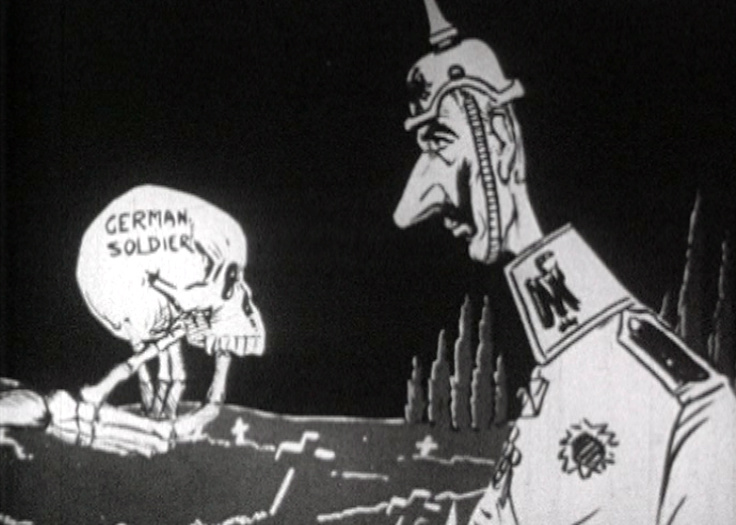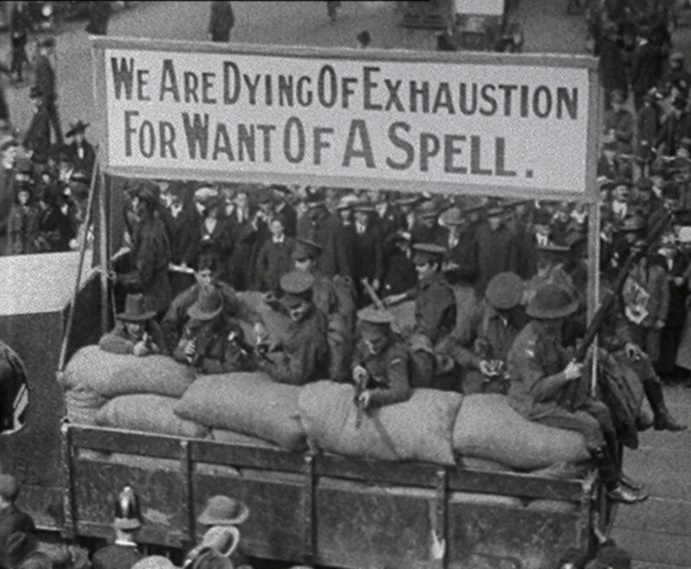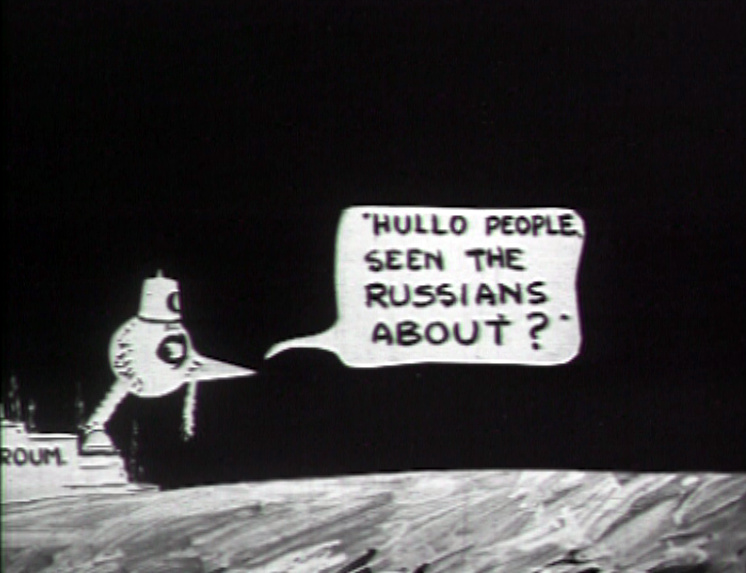Causes of WWII
PIN number: SGPMTR
-


M006983 End of the First World War and its aftermath in Australia, 1918-39
- Published 23/01/2013
- TLF-ID M006983
This is a collection of resources about the Armistice, the Treaty of Versailles and the aftermath of the First World War for Australians. It is introduced by the decoded cablegram seen here notifying the Australian prime minister that an armistice had been signed to halt hostilities. The cablegram is part of an online showcase called 'Shellshocked: Australia after Armistice', developed by the National Archives of Australia. The showcase is reached via the educational resource page for this cablegram in the Archives Virtual Reading Room (VRROOM).
View resource -


R11005 Covenant of the League of Nations, 1919
- Published 09/09/2013
- TLF-ID R11005
This is the first page of the Covenant of the League of Nations, which is Part 1 of the Treaty of Versailles, the peace treaty to conclude the First World War signed at Versailles, France, on 28 June 1919 by the Allied nations and Germany. It begins with four guiding principles designed to promote international cooperation, peace and security and that underpin the articles of the Covenant. The page includes Article 1, which describes how a state can become a member of the League of Nations. It is taken from Australia's authenticated copy of the treaty.
View resource -


R9019 Cartoons of the Moment - The Kaiser War, c1918
- Published 29/06/2011
- TLF-ID R9019
This black-and-white clip shows three animated Australian political cartoons created during the First World War. Cut-out animation with captions satirise Kaiser Wilhelm's failure to take responsibility for the war dead represented by piles of skulls and crosses. The second sequence 'Look out Billy' shows the comical figure of a suffragette whose advances are rejected by prime minister Billy Hughes. The final cartoon shows the Sun with the face of Kaiser Wilhelm being eclipsed by the face of King George V.
View resource -


R7478 Australasian Gazette, c1917: Returned Anzacs
- Published 29/06/2011
- TLF-ID R7478
This silent black-and-white clip shows returned Australian First World War soldiers parading through the streets of Melbourne. The placards indicate that the march was an appeal for more recruits to join the Army and it may been in support of the 1916 referendum campaign. The parade comprises marching bands, soldiers in various styles of uniforms, civilians, military hardware and a number of floats including a replica tank and a British bulldog straddled by a young man in a sailor's uniform. Many of the marchers are carrying placards reading 'WANTED / A MAN TO FILL THIS GAP'. Spectators, standing three to four people deep, line the route. The footage from an Australasian Gazette newsreel opens with a title card and includes eight shots that cover the parade from different vantage points.
View resource -


R11028 Etaples Military Cemetery, France, c1920s
- Published 09/09/2013
- TLF-ID R11028
This is a black-and-white photograph of part of the Etaples Military Cemetery in northern France, taken in the 1920s. The large Cross of Sacrifice and trees either side of it are silhouetted against a cloudy sky as the sun rises over the Canche River estuary. A person stands looking towards the cross.
View resource -


R9409 'Ypres', 1917-18
- Published 09/09/2013
- TLF-ID R9409
This oil painting by John Power shows a lone tall figure shrouded in a full-length hooded grey, purple and red robe that exposes bare feet but covers a bowed head. The figure stands at the base of a strong timber post that reaches into the sky. The landscape in the middle rear is undulating and bare. Beyond that, there appears to be a chasm and beyond the chasm, silhouetted against the sky, are the ruins of Ypres including its old Cloth Hall. The ruins emit wisps of smoke that rise through clouds in a still, sombre-hued sky. The painting measures 76.4 cm x 45.8 cm.
View resource -


R1967 Referendum bullets: AIF divisions
- Published 10/05/2011
- TLF-ID R1967
This is a silent black-and-white film clip of Australian soldiers marching along a road. The shot is framed on the right by a large gum tree. The words 'REFERENDUM BULLETS. By W. M. HUGHES. Australia has 100,000 men, five divisions, in the battle line. Our task is to maintain these five divisions at their full strength.' are superimposed on the film. It is one of the political advertisements in favour of conscription made in 1916 for William Morris 'Billy' Hughes, then Labor Prime Minister.
View resource -


R1969 Referendum bullets: scabs
- Published 10/05/2011
- TLF-ID R1969
This is a silent black-and-white film clip of Australian soldiers marching down a city street facing the camera. It shows their faces, rifles and uniforms. The words 'REFERENDUM BULLETS. By W. M. HUGHES. The Antis ask you to throw in the towel on the 28th. Are you going to scab on the Anzacs?' are superimposed on the film. It is one of the political advertisements in favour of conscription made in 1916 for William Morris 'Billy' Hughes, then Labor Prime Minister.
View resource -


R1971 Referendum bullets: a blackleg
- Published 10/05/2011
- TLF-ID R1971
This is a silent black-and-white film clip of Prime Minister William Morris ‘Billy’ Hughes speaking with notes in hand, in a garden setting with a trellis and large pine tree behind him. The words 'REFERENDUM BULLETS. By W. M. HUGHES. Those who vote ''No'' will make the Australian Commonwealth the first blackleg among the Allies.' are superimposed on the film. It is one of the political advertisements in favour of conscription made in 1916 for Hughes, then Labor Prime Minister.
View resource -


R1972 Referendum bullets: invasion threat
- Published 10/05/2011
- TLF-ID R1972
This is a silent black-and-white film clip of a First World War warship steaming into a harbour. The words 'REFERENDUM BULLETS. By W. M. HUGHES. If Australia were ever threatened with invasion, we would shudder to think that Britain might vote ''NO.''' are superimposed on the film. It is one of the political advertisements in favour of conscription made in 1916 for William Morris 'Billy' Hughes, then Labor Prime Minister.
View resource -


R9017 Cartoons of the Moment - German Dove of Peace, c1916: The Rushin bear and flying Turk
- Published 29/06/2011
- TLF-ID R9017
This black-and-white clip shows an animated cartoon using paper cut outs of animals to represent the two nations Turkey and Russia in order to comment satirically on an incident in the First World War. Speech balloons explain the action. The Russian bear, uniformed and with bayoneted rifle at the ready, advances across the screen. Next, the hand of the artist draws the fez-wearing turkey that has arrived in a boat hoping that the bear is not around, but the bear appears and chases the turkey off the screen.
View resource -


R8586 'Anzac, the landing 1915'
- Published 07/09/2013
- TLF-ID R8586
This unusually large oil painting on canvas (190.5 cm x 350.5 cm) depicts the near-impossible task that confronted soldiers of the Australian and New Zealand Army Corps during the landing at Gallipoli in Turkey on 25 April 1915. Diminutive men in angular postures are being fired upon from above as they attempt to scale jagged cliffs rising from a small beach area known today as Anzac Cove. Scattered scrub and dead and wounded men impede the climbers' progress. Small clouds of shellfire linger in the air. It was painted by George Lambert in 1920-22.
View resource -


R8588 'The charge of the 3rd Light Horse Brigade at the Nek, 7 August 1915'
- Published 07/09/2013
- TLF-ID R8588
This is a painting showing soldiers of the 3rd Australian Light Horse Brigade launching from their trenches at Gallipoli to cross a small plain with the intention of capturing Turkish trenches. Some men are running directly into machine-gun fire at close range, some are lying dead on the ground, and others are falling after having been shot. The ground is rocky and in the distance are soft purple-coloured hills. The oil on canvas painting was created by George Lambert in 1924 and measures 152.5 cm x 305.7 cm.
View resource -


R1904 Battlefield in France
- Published 10/05/2011
- TLF-ID R1904
This is an excerpt from a silent documentary made in 1916, entitled 'World War I: Australian troops in the Middle East and France'. It shows troops and horses moving along muddy roads on a battlefield in France.
View resource -


R9662 Australian soldiers on duckboards, First World War, 1917
- Published 09/09/2013
- TLF-ID R9662
This black-and-white photograph shows five Australian soldiers, members of a battery of the 10th Field Artillery Brigade of the Australian 4th Division, walking on a duckboard track through the war-devastated remains of Chateau Wood on the Western Front in Belgium. The track is laid across both the mud and the water to enable the men to pass without sinking into a quagmire. Trees have been uprooted, snapped in half and defoliated by the force of shellfire blasts. The blasted imagery extends into the horizon. The photograph was taken on 29 October 1917.
View resource -


R1960 Referendum bullets: cooee
- Published 10/05/2011
- TLF-ID R1960
This is a silent black-and-white film clip with the words 'REFERENDUM BULLETS. By W. M. HUGHES. You would answer a Coo-ee for help in the bush. The Anzacs are Coo-eeing.', superimposed over footage of First World War Australian soldiers filing along a trench. It is one of the political advertisements in favour of conscription made in 1916 for William Morris 'Billy' Hughes, then Labor Prime Minister.
View resource -


R1961 Referendum bullets: the Kaiser
- Published 10/05/2011
- TLF-ID R1961
This is a piece of black-and-white silent film footage. It opens with a photograph of Kaiser Wilhelm II of Germany in military uniform on horseback. The words 'REFERENDUM BULLETS. By W. M. HUGHES. If you vote ''No.'' spell it ''Nein.'' That is how the Kaiser would spell it. Vote ''Yes'' -- Fame, Success; Vote No -- Dishonour, woe.' appear on screen, superimposed over the photograph. It is one of the political advertisements in favour of conscription made in 1916 for William Morris 'Billy' Hughes, then Labor Prime Minister.
View resource -


R1962 Referendum bullets: 96-hour shift
- Published 10/05/2011
- TLF-ID R1962
This is a silent black-and-white film clip of Australian soldiers moving through trenches, apparently under shellfire in the First World War. The words 'REFERENDUM BULLETS. By W. M. HUGHES. Do you want to save men in the trenches from a 96-hour shift under shell fire? Then vote ''YES'' for Reinforcements.' are superimposed over the film. It is one of the political advertisements in favour of conscription made in 1916 for William Morris 'Billy' Hughes, then Labor Prime Minister.
View resource -


R1964 Referendum bullets: shirkers
- Published 10/05/2011
- TLF-ID R1964
This is a silent black-and-white film clip of the final straight of a racecourse, with the camera slowly closing in on the racehorses and their jockeys as they pass the finishing post, with racegoers massed in the background. The words 'REFERENDUM BULLETS. By W. M. HUGHES. Preserve the lives of the Anzacs, which are as sacred as the lives of the shirkers, by voting ''Yes.''' are superimposed on the film. It is one of the political advertisements in favour of conscription made in 1916 for William Morris 'Billy' Hughes, then Labor Prime Minister.
View resource -


R1968 Referendum bullets: take the count
- Published 10/05/2011
- TLF-ID R1968
This is a silent black-and-white film clip of Australian soldiers marching down a city street, led by a band and soldiers on horseback. It shows crowds standing in the road lining the route and some women, children and men walking quickly behind the crowds to keep up with the marchers. The words 'REFERENDUM BULLETS. By W. M. HUGHES. Is Australia going to take the count after October 28th? The only proper backing for Anzacs is more Anzacs.' are superimposed on the film. It is one of the political advertisements in favour of conscription made in 1916 for William Morris 'Billy' Hughes, then Labor Prime Minister.
View resource -


R1970 Referendum bullets: the Lusitania and other atrocities
- Published 10/05/2011
- TLF-ID R1970
This is a silent black-and-white film clip of the SS 'Lusitania' steaming along, with the camera view moving from astern to the bow and then to a close-up of the four funnels. The words 'REFERENDUM BULLETS. By W. M. HUGHES. Are you going to remain passive, remembering the ''Lusitania,'' the Belgian horrors, Nurse Cavell, and Captain Fryatt?' are superimposed on the film. It is one of the political advertisements in favour of conscription made in 1916 for William Morris 'Billy' Hughes, then Labor Prime Minister.
View resource -


R9407 Australian artillery drivers passing ruins at Ypres, 1917
- Published 09/09/2013
- TLF-ID R9407
This black-and-white photograph shows three Australian artillery drivers of the First World War with six horses pausing to be photographed. The horses are drawing a loaded limber (gun-carriage with shells) past the ruins of the Cloth Hall in Ypres, Belgium. The soldiers are on their way to the nearby front, also in Belgium. A fourth soldier on a separate horse is an escort. The cobbled road and town square have been cleared of rubble. The quiet scene belies the evidence of earlier shellfire. The photograph was taken on 14 September 1917.
View resource -


R2924 Morning at Passchendaele, 1917
- Published 30/08/2013
- TLF-ID R2924
This is a black-and-white composite photograph, taken by Frank Hurley on the morning after the first battle of Passchendaele during the First World War, showing Australian infantry survivors laying out and placing blankets over dead soldiers around a blockhouse near the site of Zonnebeke Railway Station in Belgium on 12 October 1917. In the background the sun's rays shine from behind a threatening cloud. The photograph measures 5 cm x 48.8 cm.
View resource -


R1901 German prisoners of war
- Published 10/05/2011
- TLF-ID R1901
This is an excerpt from a silent documentary made in 1916, entitled 'World War I: Australian troops in the Middle East and France'. It shows wounded German soldiers in France, walking through bare, war-ravaged countryside, and taking a meal break, possibly near a wheat field.
View resource -


R9408 Australian troops in a dugout at Ypres, 1917
- Published 09/09/2013
- TLF-ID R9408
This black-and-white photograph shows Australian soldiers standing and sitting on benches around a fire, listening to one of their fellow soldiers. The men are in a large dugout or larger excavation of an area under a building, evidenced by three solid wood, rock or concrete supports. The soldiers are relaxed, several are smiling. One smokes a cigarette. Some have removed their battle helmets, and a gun is propped against a case or other equipment in the foreground. The photograph was taken in Ypres, Belgium, on 28 October 1917.
View resource -


R4387 Alec Campbell recalls the 1915 Anzac landing
- Published 29/06/2011
- TLF-ID R4387
This is a sound recording, made in 2000-01, in which Gallipoli veteran Alec Campbell (1899-2002) remembers the shock, as a 16-year-old, of first seeing a man killed. He comments on the danger at Gallipoli because of the lack of cover, and goes on to note that half of his company became casualties. He concludes with the memory of seeing a pair of legs sticking out of a bush.
View resource -


R9406 'Over the top', c1918
- Published 09/09/2013
- TLF-ID R9406
This black-and-white composite photograph shows Australian soldiers during the First World War charging into battle from deep trenches while three combat aircraft fly overhead and another aircraft burns on the ground. The men wear battle uniform, including steel helmets, packs and rifles with fixed bayonets, and run across a devastated landscape towards the enemy. They appear diminutive against the expansive terrain and the smoke-clouded sky. Shells burst midair and on the ground, where they cast up soil.
View resource -


R1908 Australian troops in the trenches
- Published 10/05/2011
- TLF-ID R1908
This is an excerpt from a silent documentary made in 1916, entitled 'World War I: Australian Troops in the Middle East and France'. It shows Australian troops on the Western Front, moving through a trench, and the devastated landscape of the battleground.
View resource -


R9413 Watching the barrage from Mont Kemmel, 1918
- Published 09/09/2013
- TLF-ID R9413
This lithograph on paper shows a group of men, mostly soldiers, in coats and caps on Mont Kemmel near Ypres, Belgium, during the First World War. The men are silhouetted against flares and shellfire from a night-time artillery barrage. Some of the men are sitting and others are standing, but all are watching what is happening in the distance. A marker flag takes centre position. The land undulates into the inferno in the distance. This lithograph measures 52.2 cm x 78.0 cm.
View resource
